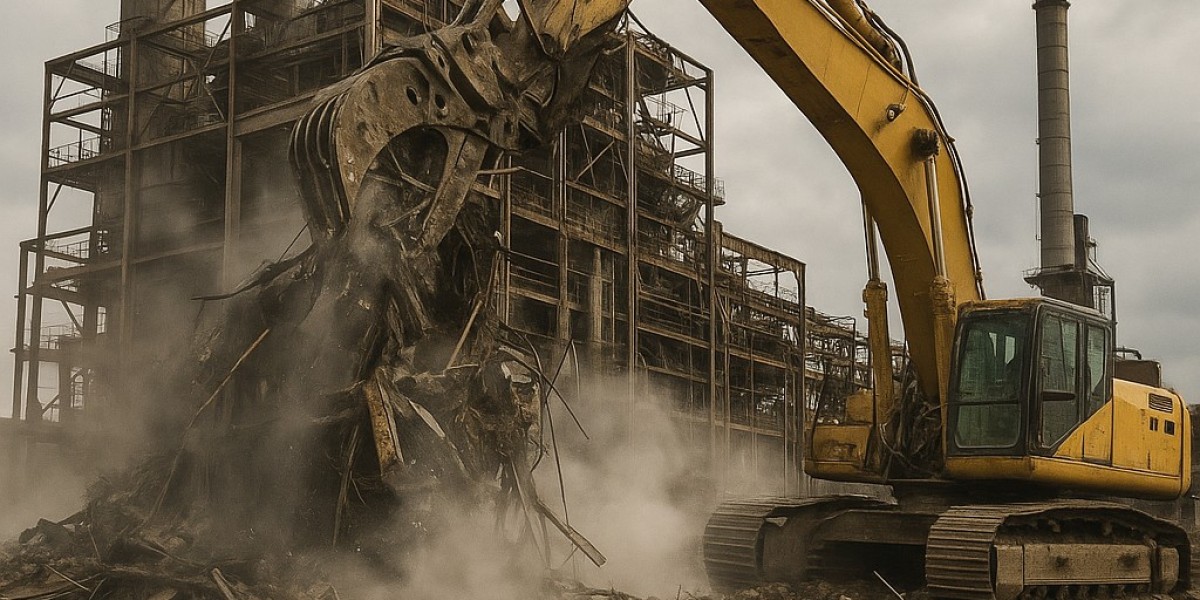Industrial demolition is a specialized segment within the demolition industry that involves the safe and strategic dismantling of large-scale industrial structures. These may include factories, warehouses, processing plants, refineries, power stations, and other heavy-duty facilities. Unlike residential or commercial demolition, industrial demolition is a complex and highly regulated process that demands precision, planning, and specialized expertise.
What is Industrial Demolition?
Industrial demolition refers to the process of tearing down industrial buildings and infrastructure while ensuring minimal disruption to surrounding environments. It can involve full demolition (complete removal of the structure) or selective demolition (removing only certain parts while preserving the rest).
Industrial sites often contain hazardous materials like asbestos, lead, and chemical residues, which require careful handling and disposal. Additionally, these structures may have deeply embedded foundations, reinforced concrete, steel frameworks, or massive equipment that complicates the demolition process.
Key Reasons for Industrial Demolition
Obsolete Structures: Older buildings that no longer meet current safety or operational standards.
Site Redevelopment: Clearing land for new construction or repurposing for modern industrial needs.
Environmental Compliance: Demolishing facilities that violate modern environmental laws.
Damage Beyond Repair: Structures damaged by fire, explosions, natural disasters, or accidents.
Economic Considerations: Sometimes, it's more cost-effective to demolish and rebuild than to renovate.
The Industrial Demolition Process
1. Planning and Permits
The process begins with an in-depth site survey, structural assessments, environmental evaluations, and risk analysis. Before any physical work starts, contractors must obtain permits from local and federal authorities, especially if hazardous materials are involved.
2. Site Preparation
This stage includes:
Disconnecting utilities (electricity, gas, water, etc.)
Setting up safety zones and fencing
Creating a detailed demolition plan
Asbestos and hazardous material removal (abatement)
3. Selective Dismantling
In many cases, machinery, equipment, and reusable materials are removed before the actual demolition. Salvageable metals, components, and materials are recycled or resold.
4. Demolition Execution
Techniques include:
Mechanical Demolition: Using heavy machinery such as excavators, bulldozers, wrecking balls, and cranes.
Implosion: Controlled use of explosives for quick demolition of large structures.
Deconstruction: Manual dismantling for maximum salvage and minimum waste.
Hydraulic Bursting or Cutting: Used for precision removal of reinforced concrete or steel.
5. Waste Management and Recycling
Debris is sorted, processed, and transported for recycling, reuse, or proper disposal. Environmental regulations demand minimal landfill waste and responsible handling of toxic substances.
6. Site Restoration
Once demolition is complete, the site may be:
Backfilled and leveled
Cleared of contaminants
Prepared for new construction or left as open space
Challenges in Industrial Demolition
Environmental Hazards: Dealing with chemical residues, asbestos, and other pollutants.
Structural Complexity: Large buildings with complex frameworks require precise engineering.
Regulatory Compliance: Strict laws govern industrial demolition to protect public safety and the environment.
Noise and Dust Control: Ensuring nearby communities and workers are not adversely affected.
Cost and Time Management: Balancing budgets with timelines without compromising safety.
Benefits of Professional Industrial Demolition
Efficiency: Experienced crews use advanced equipment to complete projects quickly and safely.
Safety: Professionals adhere to strict safety protocols, reducing risks for workers and the public.
Environmental Responsibility: Licensed companies follow best practices for waste disposal and recycling.
Permit Handling: Experts manage paperwork and regulatory compliance on behalf of clients.
Choosing the Right Industrial Demolition Contractor
When hiring a contractor, consider:
Licenses, certifications, and insurance
Experience with similar industrial projects
Safety record and compliance history
Equipment and technology used
References and reputation in the industry
Future Trends in Industrial Demolition
Robotics and Automation: Drones, robotic arms, and remote-controlled equipment enhance safety and efficiency.
Green Demolition: Greater emphasis on sustainability and recycling materials.
Data-Driven Planning: 3D modeling and digital simulations for better project execution.
Stricter Regulations: More laws focusing on environmental protection and worker safety.
Conclusion
Industrial demolition is more than tearing down buildings—it’s a critical process that paves the way for progress, renewal, and environmental responsibility. From initial planning and safety assessments to waste recycling and site rehabilitation, every phase requires precision and professionalism. Choosing the right team ensures not only the successful completion of the demolition but also the protection of the environment and the community.






